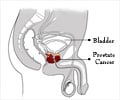University of Michigan Comprehensive Cancer Center’s research team, including an Indian-origin scientist, has found how two genes fuse together and lead to prostate cancer.
University of Michigan Comprehensive Cancer Center’s research team, including an Indian-origin scientist, has found how two genes fuse together and lead to prostate cancer.
The study found that pieces of chromosome relocate near each other after exposure to the hormone androgen, which sets the scene for the gene fusion to occur."This work shows the origin of how the gene fusion is actually created and perhaps the origin of prostate cancer itself. This is a triggering event for the genesis of prostate cancer," said study author Dr. Arul Chinnaiyan.
In 2005, the researchers identified a prostate-specific gene called TMPRSS2 that fuses with the gene ERG, which is known to play a role in prostate cancer.
Their earlier research has shown that this gene fusion acts as an "on switch" to trigger prostate cancer.
In the current study, the researchers focused on what causes the gene fusion to occur.
They took prostate cancer cells that did not reflect the gene fusion but that were sensitive to androgen, a male hormone known to play a role in some prostate cancers.
Advertisement
Then, the researchers applied radiation to the androgen-stimulated cells.
Advertisement
"We thought the gene fusions occurred as a chance event, but it's not. Chromosomes can actually be induced in three-dimensional space to be close to each other. Then when an insult to the DNA occurs, the fusion happens," said lead study author Dr. Ram-Shankar Mani.
The researchers believe the findings could have implications for gene fusions that occur in other cancer types.
The researchers suggest that by understanding how gene fusions occur, screening tools or prevention strategies could potentially be developed.
The finding has been published in Science Express.
Source-ANI
ARU




![Prostate Specific Antigen [PSA] Prostate Specific Antigen [PSA]](https://www.medindia.net/images/common/patientinfo/120_100/prostate-specific-antigen.jpg)








